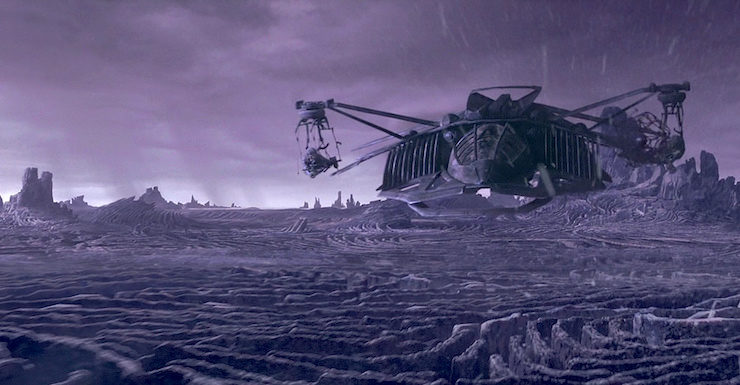There’s just something extra special about a backdrop of bubbling lava, snapping tentacles, poisonous forests, sinkholes, cracking ice, an unbreathable atmosphere, or the approach of a blistering sunrise that amps up the excitement factor. The story was probably already pretty good, but now everyone might die on the way to wherever they’re going. And they might die horribly because someone thought it was a good idea to visit Paradise Not.
That someone could easily be me. I have a habit of putting my characters in horrible places and I’m going to place the blame on some of my favorite books and movies. We’ll start with Ursula K. Le Guin, who is known for testing every limit her characters have—and then some…
The Left Hand of Darkness by Ursula K. Le Guin
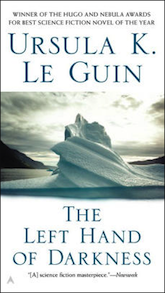 This is not the first book of Le Guin’s I ever read, but the one I remember the best. I find the themes of gender identity refreshingly challenging. But when I talk about The Left Hand of Darkness, I usually end up describing the part where Genly and Estraven spend eighty days traversing the northern Gobrin ice sheet. The environment is unspeakably harsh and Le Guin makes it enthralling. I could feel the fat melting away from Genly and Estraven as they balanced their daily calorie expense against necessary exertion. I shivered when I learned that it doesn’t snow when the temperature drops below a certain threshold. I didn’t ever want to know how cold that must be.
This is not the first book of Le Guin’s I ever read, but the one I remember the best. I find the themes of gender identity refreshingly challenging. But when I talk about The Left Hand of Darkness, I usually end up describing the part where Genly and Estraven spend eighty days traversing the northern Gobrin ice sheet. The environment is unspeakably harsh and Le Guin makes it enthralling. I could feel the fat melting away from Genly and Estraven as they balanced their daily calorie expense against necessary exertion. I shivered when I learned that it doesn’t snow when the temperature drops below a certain threshold. I didn’t ever want to know how cold that must be.
Not lost on me was the fact that the beyond bitter cold was the backdrop for the most important part of the book—Genly and Estraven learning to trust each other. It’s similar to putting two adversaries in a remote cabin with only one way in and one way out—and blocking that entrance with a grizzly. Makes a good argument for even a temporary truce, doesn’t it?
The Chronicles of Riddick
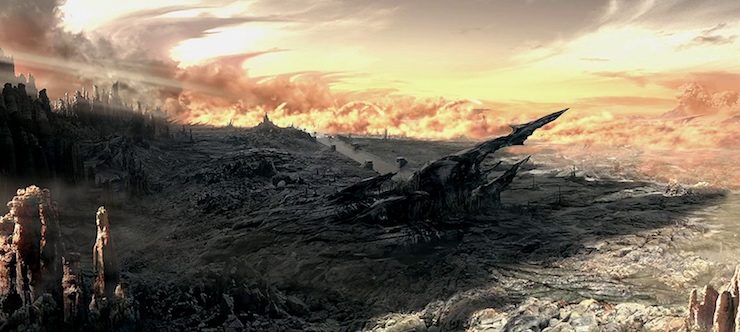
On the opposite end of the spectrum, we have Crematoria! I love this planet and not just because of the suggestion that about five hundred years in the future we’ll still be claiming the best real estate for prisons—in this case, a planet that will freeze your behind by night, only to roast it in the morning. If someone were able to escape the triple max prison buried deep beneath the surface of this abused planet, they’d probably die pretty quickly.
But not Richard Riddick. He and and an old friend plot their escape during the brief window between night and day. As if the terrain weren’t enough—smoking pits of… smoke, crumbling cliffs, falling ash—the sun is rising. The effect is awesome, like a spirograph of light on the far horizon. I won’t spoil the rest, except to note that the highlight of the movie, for me, is when half the party gets stuck by the advancing line of daylight and fiery plumes of lava.
2312 by Kim Stanley Robinson
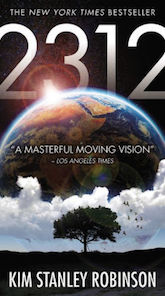 I love to hike and have aspirations of one day completing more than a single span of the Appalachian Trail. If we had an outpost on Mercury—either underground, or rolling across the surface in advance of the sun as depicted in Kim Stanley Robinson’s novel 2312—I’d probably want to hike there. The book begins with a tantalizing invitation:
I love to hike and have aspirations of one day completing more than a single span of the Appalachian Trail. If we had an outpost on Mercury—either underground, or rolling across the surface in advance of the sun as depicted in Kim Stanley Robinson’s novel 2312—I’d probably want to hike there. The book begins with a tantalizing invitation:
The sun is always about to rise. Mercury rotates so slowly that you can walk fast enough over the rocky surface to stay ahead of the dawn; and so many people do. Many have made this a way of life. They walk roughly westward, staying always ahead of the stupendous day.
Robinson goes on to detail how some walkers dally in certain locations to watch the sun spread across the horizon behind them, some so in awe of the spectacle that they almost forget to run farther westward in time to outpace the dawn. There’s also a city called Terminus that rolls around the planet on a train—always ahead of the sun. One of my favorite adventures actually takes place beneath the tracks as Swan takes shelter from the sun only to be trapped for weeks in underground tunnels. Do I need to mention that I’m also fond of perilous journeys?
Master Sergeant by Mel Odom
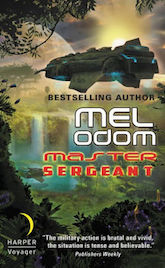 In Master Sergeant, Mel Odom introduces us to Makaum, otherwise known as the Green Hell. The planet is a maze of vicious vegetation defying every effort at containment. Like the burning sun and endless ice I’ve mentioned above, the jungle is inimitable, and it shapes the entire culture of the planet. It cannot be beaten back, but only be controlled for short periods of time, say for the purpose of clearing a landing pad. It’s a horrific and oppressive environment that leaves you wondering why anyone would want to live there.
In Master Sergeant, Mel Odom introduces us to Makaum, otherwise known as the Green Hell. The planet is a maze of vicious vegetation defying every effort at containment. Like the burning sun and endless ice I’ve mentioned above, the jungle is inimitable, and it shapes the entire culture of the planet. It cannot be beaten back, but only be controlled for short periods of time, say for the purpose of clearing a landing pad. It’s a horrific and oppressive environment that leaves you wondering why anyone would want to live there.
Turns out, the planet is rich in natural resources. Of course it is! This is science fiction at its best. Why put the most sought after mineral in the galaxy on a barren rock where anyone can get at it when you can bury it beneath a man-eating jungle on a planet also infested with drug runners and gangs? Seriously.
Master Sergeant is military science fiction, which I also love, and outside the superlative world building also tells a great story. Inclusion on this list, though, is down to the jungle. Imagine a world where you can’t walk a foot without bumping into herbicide and fire resistant poison ivy? Lots of it. Then make it carnivorous. Further imagine how an environment like that would shape your life? I want to write that book. I have notes for that book.
Interstellar
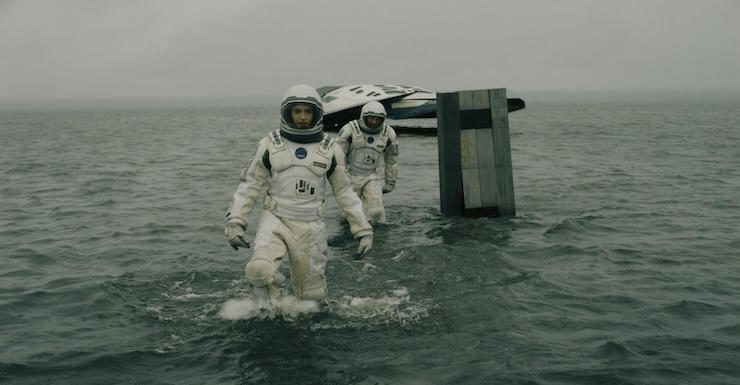
Lastly, let’s talk about Miller’s Planet from the movie Interstellar. Without giving too much away—it’s not a viable choice for colonization. The why of it is what makes it so fascinating, though. Not only is there a severe time dilation effect, meaning that time passes more slowly on the surface than it does outside orbit, but the place is literally one big ocean… and the black hole hovering over the horizon means there are some wicked tides. (The black hole also responsible for the time thing.)
There is land at the bottom of the sea, but both will disappear when the next wave hurtles past—at the height of Mount Everest. Disastrous and not particularly welcoming, but fascinating nonetheless. Ever since seeing the movie, I’ve pondered ways in which such a planet could be made habitable. I’ll let you know if I come up with something.
So, are you ready to visit Paradise Not? Inhospitable environments occur frequently in all forms of fiction—and in our own world—inspiring some of the greatest stories of people surviving against all odds, emerging perhaps damaged, always deeply affected, but also stronger and with greater resolve. These settings are often the ultimate test, and that’s why I love them so much.
 If aliens ever do land on Earth, Kelly Jensen will not be prepared, despite having read over a hundred stories of the apocalypse. Still, she will pack her precious books into a box and carry them with her as she strives to survive. It’s what bibliophiles do. Kelly is the author of a number of novels, novellas and short stories, including the Chaos Station series, co-written with Jenn Burke. Her latest release is To See the Sun, a queer SFF Romance featuring two men looking for a place to finally call home and finding it on an inhospitable planet on the edge of the galaxy. You can find her on Twitter @kmkjensen.
If aliens ever do land on Earth, Kelly Jensen will not be prepared, despite having read over a hundred stories of the apocalypse. Still, she will pack her precious books into a box and carry them with her as she strives to survive. It’s what bibliophiles do. Kelly is the author of a number of novels, novellas and short stories, including the Chaos Station series, co-written with Jenn Burke. Her latest release is To See the Sun, a queer SFF Romance featuring two men looking for a place to finally call home and finding it on an inhospitable planet on the edge of the galaxy. You can find her on Twitter @kmkjensen.










